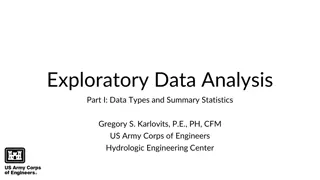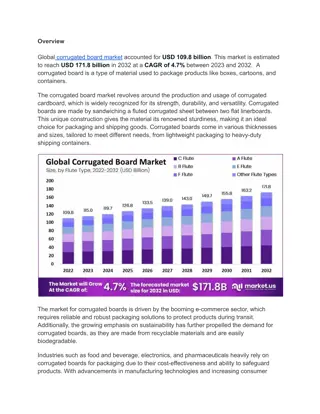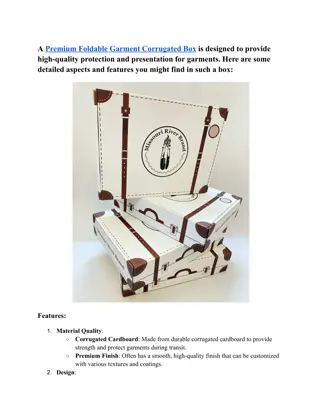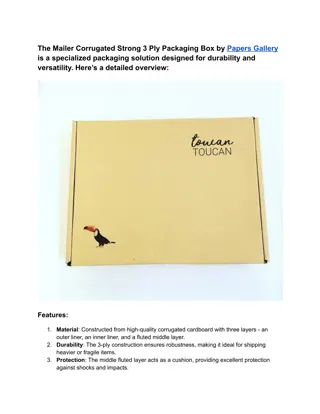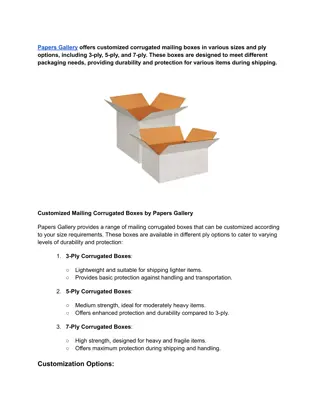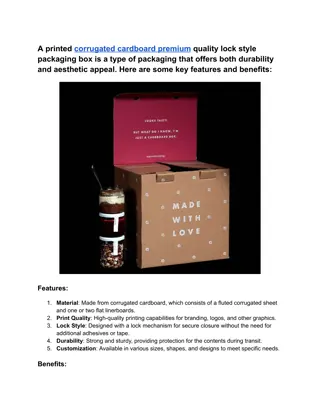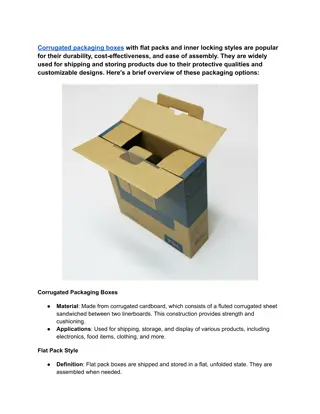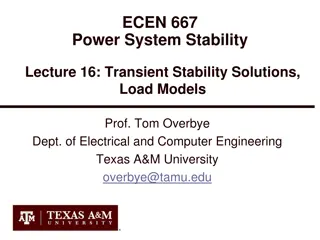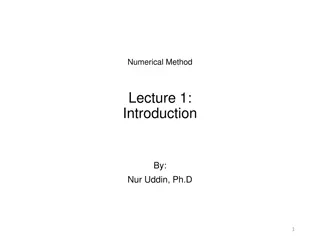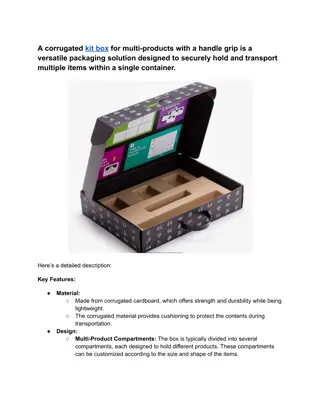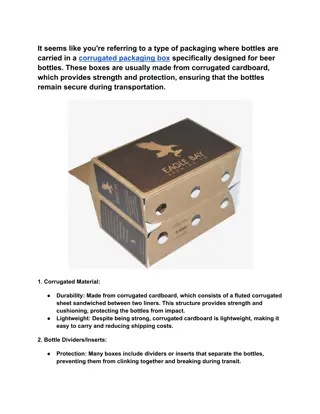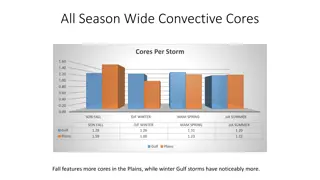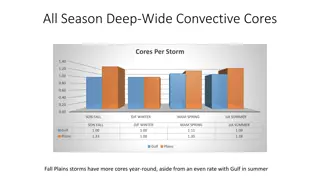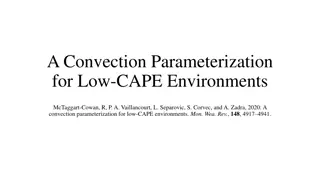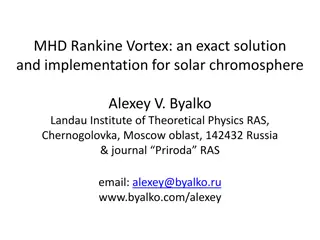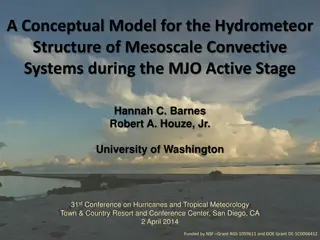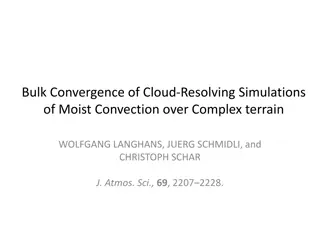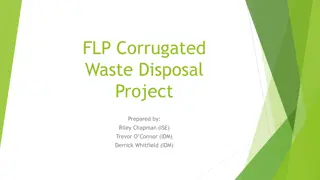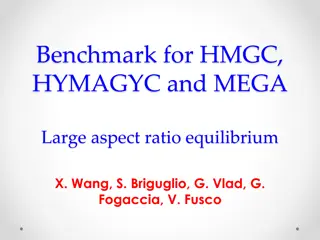Numerical Study of MHD Convective Nanofluid Flows within Corrugated Trapezoidal Enclosure
Study investigates the influence of sidewall inclination angle and Eckert number on unsteady flow and heat transfer in alumina-water and SWCNT-water nanofluids within a trapezoidal enclosure. Motivation stems from the heat transfer enhancement in trapezoidal geometries compared to rectangular ones, with aims to enhance heat transfer performance using nanofluids. Assumptions include negligible magnetic Reynolds number and electric force, along with neglecting thermal radiation. Governing equations for continuity, momentum, and energy examined.
Uploaded on Oct 03, 2024 | 3 Views
Download Presentation

Please find below an Image/Link to download the presentation.
The content on the website is provided AS IS for your information and personal use only. It may not be sold, licensed, or shared on other websites without obtaining consent from the author.If you encounter any issues during the download, it is possible that the publisher has removed the file from their server.
You are allowed to download the files provided on this website for personal or commercial use, subject to the condition that they are used lawfully. All files are the property of their respective owners.
The content on the website is provided AS IS for your information and personal use only. It may not be sold, licensed, or shared on other websites without obtaining consent from the author.
E N D
Presentation Transcript
NUMERICAL STUDY OF MHD CONVECTIVE NANOFLUID FLOWS WITHIN A CORRUGATED TRAPEZOIDAL ENCLOSURE Victor M. Job1, Sreedhara Rao Gunakala2, P.V.S.N. Murthy3, R. Panneer Selvam4 1,2Department of Mathematics and Statistics, The University of the West Indies, Trinidad 3Department of Mathematics, Indian Institute of Technology Kharagpur, India 4Department of Civil Engineering, University of Arkansas, U.S.A. IConETech-2020, Faculty of Engineering, The UWI, St. Augustine, Trinidad and Tobago 1
INTRODUCTION Free convection flows within trapezoidal enclosures Design and operation of heat exchangers or solar collectors fluid flows and heat transfer in microchannels cooling of micro-electromechanical (MEMS) systems heat transfer performance limited by the low thermal conductivities of conventional fluids: water, oil, EG. Nanofluids identified as innovative method of heat transfer enhancement. IConETech-2020, Faculty of Engineering, The UWI, St. Augustine, Trinidad and Tobago 2
MOTIVATION AND OBJECTIVES Heat transfer enhancement achieved in trapezoidal geometries compared to rectangular geometries (Mamun et al. 2010, Job and Gunakala 2016, etc.). Effects of sidewall inclination angle and Eckert number on convective nanofluid flows have not been considered. Aim: To investigate the influence of sidewall inclination angle and Eckert number on unsteady flow and heat transfer phenomena in alumina-water and SWCNT-water nanofluids. IConETech-2020, Faculty of Engineering, The UWI, St. Augustine, Trinidad and Tobago 3
PROBLEM DESCRIPTION Figure: Schematic Diagram of the Problem IConETech-2020, Faculty of Engineering, The UWI, St. Augustine, Trinidad and Tobago 4
ASSUMPTIONS Magnetic Reynolds number is very small. Electric force induced by the applied magnetic field is negligible. Thermal radiation is neglected. Temperature difference in fluid is sufficiently small - Boussinesq approximation is applicable. IConETech-2020, Faculty of Engineering, The UWI, St. Augustine, Trinidad and Tobago 5
GOVERNING EQUATIONS Continuity Equation ?? ?? +?? ??= 0 Momentum Equations ?2? ??2+?2? ?? ??? ?? ??+ ????? ?? ??? ?? ?? + ??? ?? +??? ??= ??2 ?? ?2? ??2+?2? ?? ??? ?? ??+ ????? ?? ??? ??2 ??2????? ?? ??? ? + ???? ???? ??? ?? ??? ? ?? ?? + ??? ?? +??? ??= ?? ?? Energy Equation ?2? ??2+?2? 2+ 2 ??? ?? ???? (??)??2?? ???? (??)?? ??2 + ??2????? 2 + ???? (??)?? ?2 2 ?? ?? + ??? ?? +??? +????? ??= ?? ?? ?? ?? ??+?? ?? ?? ?? IConETech-2020, Faculty of Engineering, The UWI, St. Augustine, Trinidad and Tobago 6
Initial/Boundary Conditions Initial Conditions: ? = ? = ? = 0 at ? = 0 Boundary Conditions: ? = ? = 0,? = 1 on the bottom wall ? = ? = ? = 0 on the left and right walls ? = ? = 0,?? ??= 0 on the top wall IConETech-2020, Faculty of Engineering, The UWI, St. Augustine, Trinidad and Tobago 7
METHODOLOGY Mixed Finite Element Method Piecewise linear interpolation on triangular elements Polynomial Pressure Projection Stabilization Mesh with 8148 elements used to ensure sufficient accuracy of solution Method implemented in MATLAB IConETech-2020, Faculty of Engineering, The UWI, St. Augustine, Trinidad and Tobago 8
RESULTS ? = 0 ? = 45 Figure: Streamline Plots (?????-Water Nanofluid) IConETech-2020, Faculty of Engineering, The UWI, St. Augustine, Trinidad and Tobago 9
RESULTS ? = 0 ? = 45 Figure: Streamline Plots (SWCNT-Water Nanofluid) IConETech-2020, Faculty of Engineering, The UWI, St. Augustine, Trinidad and Tobago 10
RESULTS ? = 0 ? = 45 Figure: Isotherm Plots (?????-Water Nanofluid) IConETech-2020, Faculty of Engineering, The UWI, St. Augustine, Trinidad and Tobago 11
RESULTS ? = 0 ? = 45 Figure: Isotherm Plots (SWCNT-Water Nanofluid) IConETech-2020, Faculty of Engineering, The UWI, St. Augustine, Trinidad and Tobago 12
RESULTS ?? = 10 5 ?? = 10 4 Figure: Streamline Plots (?????-Water Nanofluid) IConETech-2020, Faculty of Engineering, The UWI, St. Augustine, Trinidad and Tobago 13
RESULTS ?? = 10 5 ?? = 10 4 Figure: Isotherm Plots (?????-Water Nanofluid) IConETech-2020, Faculty of Engineering, The UWI, St. Augustine, Trinidad and Tobago 14
RESULTS Heat transfer rate - Average Nusselt number on the corrugated bottom wall : 1 ?? ???? ????= ?( ) Table: Average Nusselt Number for Different ? ???? (??2?3-Water Nanofluid) 3.6793 3.7336 4.7322 4.4979 4.3438 ???? (SWCNT-Water Nanofluid) 3.7411 3.8105 5.0947 4.8750 4.7946 ? 0 20 45 55 60 IConETech-2020, Faculty of Engineering, The UWI, St. Augustine, Trinidad and Tobago 15
RESULTS Table: Average Nusselt Number for Different ?? ???? (??2?3-Water Nanofluid) 4.7524 4.7322 4.0716 ???? (SWCNT-Water Nanofluid) 5.0947 5.0947 5.0947 ?? 10 6 10 5 10 4 IConETech-2020, Faculty of Engineering, The UWI, St. Augustine, Trinidad and Tobago 16
CONCLUSIONS Velocity and temperature of ??2?3-water nanofluid increased when ?? increased. Rate of heat transfer enhanced by reducing viscous and Joule dissipations. Flow circulation and fluid temperature increased as ? increased. Heat transfer rate on the corrugated wall is highest when ? 45 . Consistent with results obtained by Mamun et al. (2010). IConETech-2020, Faculty of Engineering, The UWI, St. Augustine, Trinidad and Tobago 17
REFERENCES Job, V. M. , and S. R. Gunakala. 2016. Unsteady MHD free convection nanofluid flows within a wavy trapezoidal enclosure with viscous and Joule dissipation effects. Numerical Heat Transfer, Part A: Applications 69(4): 421-443. Job, V. M., Gunakala S. R., B. Rushi Kumar, and R. Sivaraj. 2017. Time- dependent hydromagnetic free convection nanofluid flows within a wavy trapezoidal enclosure. Applied Thermal Engineering 11: 363-377. Mamun, M. A. H., Islam, M. T., and M. M. Rahman. 2010. Natural convection in a porous trapezoidal enclosure with magneto-hydrodynamic effect. Nonlinear Analysis: Modelling and Control 15(2): 159-184. IConETech-2020, Faculty of Engineering, The UWI, St. Augustine, Trinidad and Tobago 18
THANK YOU! IConETech-2020, Faculty of Engineering, The UWI, St. Augustine, Trinidad and Tobago 19


